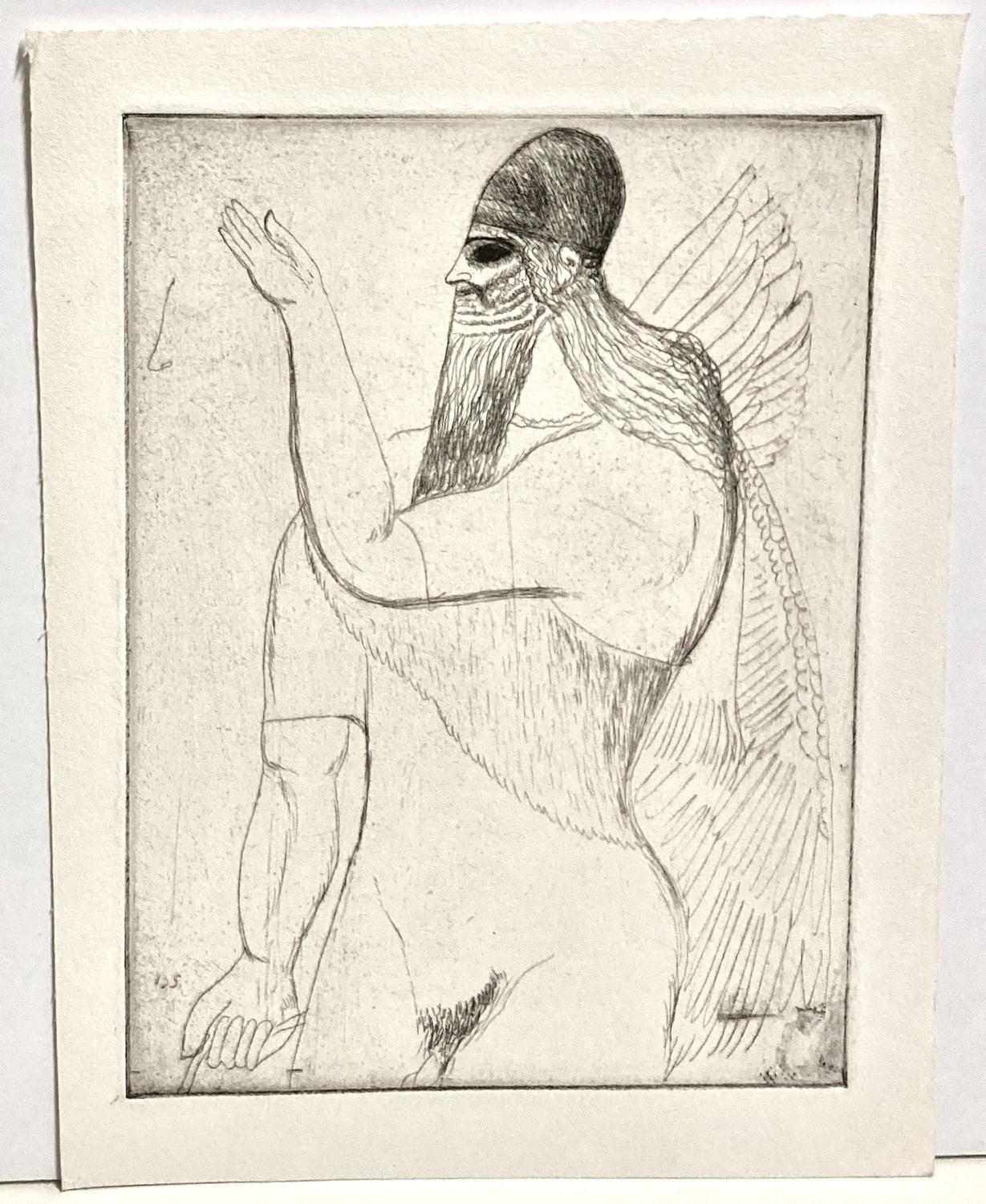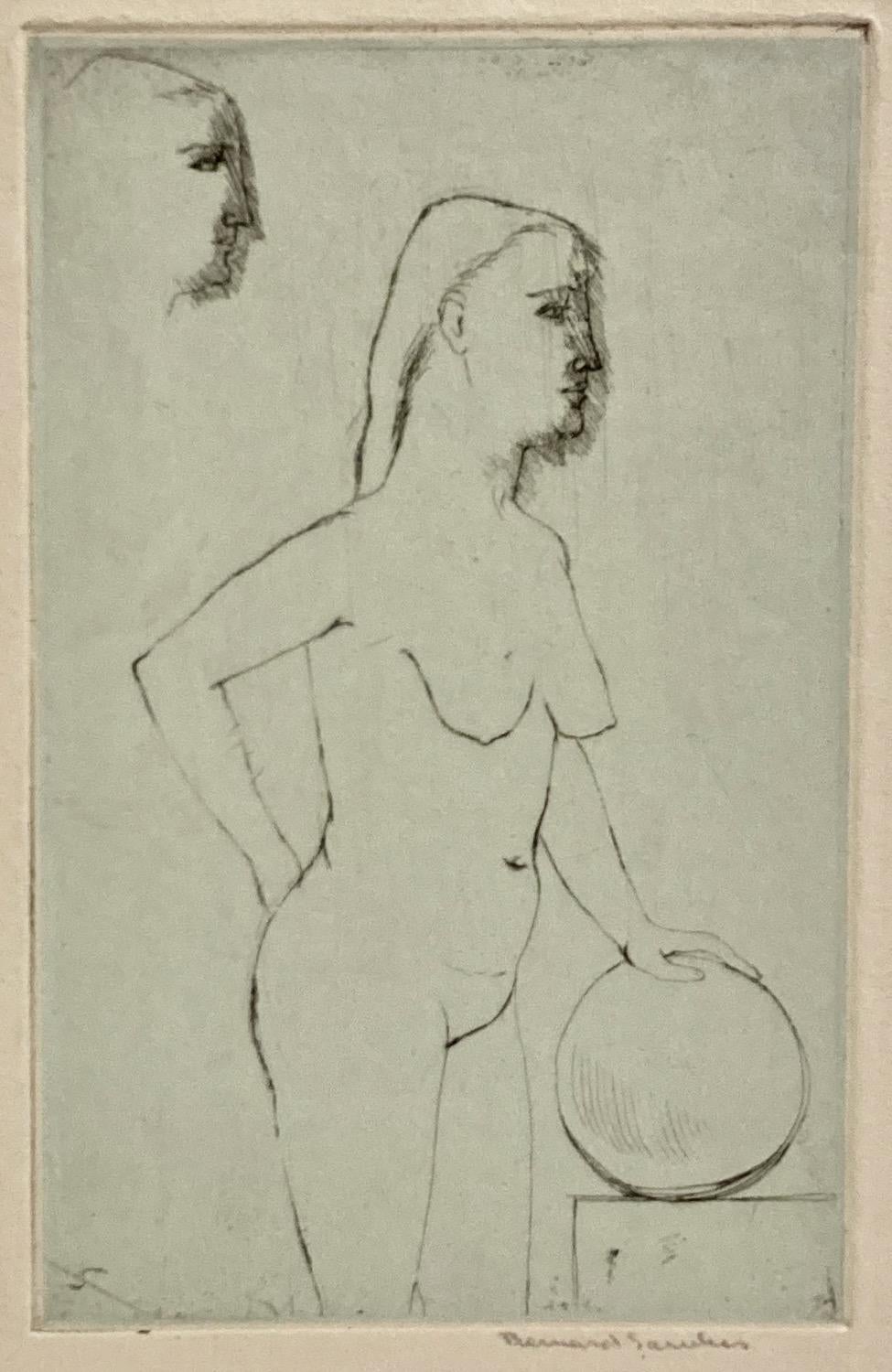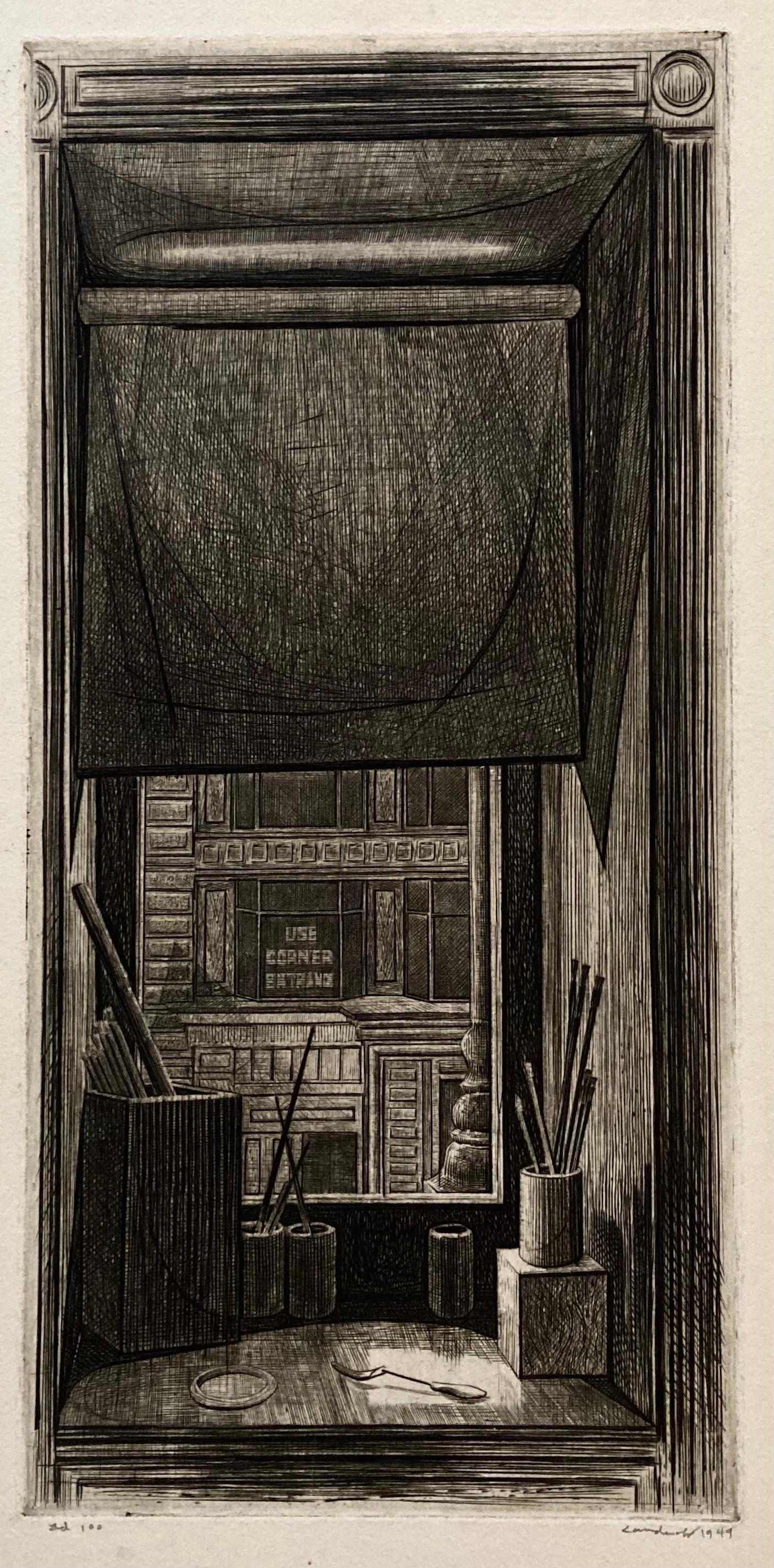Items Similar to Adele and the Ladies (Rochester's fashion conscious ward in Jane Eyre)
Want more images or videos?
Request additional images or videos from the seller
Fritz EichenbergAdele and the Ladies (Rochester's fashion conscious ward in Jane Eyre)1943
1943
About the Item
Adele, the 10 year-old girl who may be the daughter of Rochester and Celine in "Jane Eyre" is being scrutinized by three women. One is seated on an ornate sofa with a candelabra flickering in the background. Fritz Eichenberg created this wood engraving in 1943; it is signed in pencil. The image is one of very few proofs with no printed edition.
Fritz Eichenberg (1901 – 1990)
German-born wood engraver and lithographer, Eichenberg studied at the School of Applied Arts in Cologne before moving to Berlin where he was a reporter and staff artist for the Ullstein Publishing House. When Hitler came to power in 1933, Eichenberg moved to New York where he taught at the New School for Social Research and worked on the Federal Art Project. He taught at the Pratt Institute and served as the director of the Pratt Graphics Center where he edited "Artist’s Proof", a journal on printmaking.
In 1966, Eichenberg moved to Rhode Island and chaired the Art Department of the University of Rhode Island in Kingston. His wood engravings and lithographs are almost always associated with literary sources. His prints are in numerous collections including the Metropolitan Museum of Art, the Library of Congress, Yale University Library, the Hermitage, the Vatican, the Bibliotheque Nationale.
- Creator:Fritz Eichenberg (1901 - 1990, American, German)
- Creation Year:1943
- Dimensions:Height: 7.38 in (18.75 cm)Width: 5 in (12.7 cm)
- Medium:
- Movement & Style:
- Period:
- Condition:
- Gallery Location:New Orleans, LA
- Reference Number:1stDibs: LU84132634943
Fritz Eichenberg
Fritz Eichenberg was one of the world's most sought-after illustrators of literary classics, including The Brothers Karamazov and Crime and Punishment, as well as works by Edgar Allan Poe, Dylan Thomas, the Brontë sisters, and others. Born in Cologne, Germany in 1901, he learned lithography, wood-engraving, and etching and by his early twenties had produced masterful illustrations for Gulliver's Travels and Till Eulenspiegel. He came to the United States in 1933 and over the next five decades produced an astonishing range of individual images and book illustrations. Throughout his life, he was preoccupied with the tragedy of war. He became a close friend and great supporter of Dorothy Day and The Catholic Worker and used his art to express his hope for more justice in the world.
About the Seller
4.9
Platinum Seller
These expertly vetted sellers are 1stDibs' most experienced sellers and are rated highest by our customers.
Established in 1988
1stDibs seller since 2018
757 sales on 1stDibs
Typical response time: 3 hours
Associations
International Fine Print Dealers Association
- ShippingRetrieving quote...Ships From: New Orleans, LA
- Return PolicyA return for this item may be initiated within 14 days of delivery.
More From This SellerView All
- Sleeping CarBy James L. HendershotLocated in New Orleans, LAAssociated American Artists published "Sleeping Car" by James Hendershot. This image shows a rail car filled with passengers and conductors. This exhibit...Category
Late 20th Century American Modern Figurative Prints
MaterialsLithograph
- Early Morning DepartureBy James L. HendershotLocated in New Orleans, LA"Early Morning Departure" by James Hendershot is published in an edition of 40, This impression is #32 This exhibition celebrates J. L. Hendershot’s fifty-one years of teaching art: forty-eight at the College of St. Benedict/St. John's University. Hendershot’s independent studio work along with selected student works enrolled in his courses comprise the exhibition in addition to various retrospective and current explorative works, printmaking disciplines, graphite and charcoal drawings...Category
Late 20th Century American Modern Figurative Prints
MaterialsLithograph
- Fructidore (Fruit being carried is hard to distinguish from the woman's body)By Anne DykmansLocated in New Orleans, LAIn Anne Dykmans' "Fructidore", a well endowed woman uses her plaid apron to carry a bunch of fruit. Parts of her body clothed in plaid seem to suggest the same fruit she is carrying...Category
1970s Modern Interior Prints
MaterialsMezzotint
- The SacristanBy Harry MorleyLocated in New Orleans, LAThis image shows a cleric seated in a church sacristy surrounded by religious statues, croziers, various saints, statues and chalices. It is an origina...Category
Early 20th Century Modern Interior Prints
MaterialsEngraving
- Interior with Red Shawl (Young woman reads in this calm Vermeer-like interior)Located in New Orleans, LAInterior with a red shawl conveys a quite different mood and feeling: one of calm, and suspension of time. Here the suggestion is that the woman is waiting ...Category
Early 20th Century Dutch School Figurative Prints
MaterialsMezzotint
- Sew What (the swells and swirls of the stripes are now in the hands of others)By Carol WaxLocated in New Orleans, LA"Sew What" is a color mezzotint with burin engraving created in an edition of 35. This impression is #6. I love sumptuously designed textiles in both real life and art. Patterns metamorphosing over fabric folds appeal to my interest in modulating rhythmic forms, particularly the swells and swirls of calligraphic stripes. I’m also fascinated by articulated wooden hand models, which appear in many of my paintings. Combining these passions with sewing paraphernalia from my seamstress days provided inspiration for my color mezzotint engraving "Sew What". Carol Wax originally trained to be a classical musician at the Manhattan School of Music but fell in love with printmaking. Soon after she began engraving mezzotints she was asked by the renowned print dealer...Category
21st Century and Contemporary Contemporary Figurative Prints
MaterialsMezzotint
You May Also Like
- Bernard Sanders, (Mesopotamian Figure)Located in New York, NYClearly Sanders was looking at ancient Mesopotamian figures. Even the elaborate feathered wings can be found there -- made about 5000 years ago! There's an initial 'S' in the plate...Category
Early 20th Century American Modern Interior Prints
MaterialsEtching, Drypoint
- Bernard Sanders, (Nude Woman with Orb)Located in New York, NYSander's figures are captivating. Here a women stands facing right, just touching, and holding still, a globe shape, on a flat surface. It was difficult getting the color to show p...Category
Early 20th Century American Modern Interior Prints
MaterialsDrypoint, Etching
- Bernard Sanders, (Lovers)Located in New York, NYClearly Sanders (1906-1967) was a master at these minimalist figurative prints. It's all about atmosphere and tension. Perhaps reflecting the print here, (Lovers), he, in fact, w...Category
Early 20th Century American Modern Interior Prints
MaterialsEtching, Drypoint
- Interiors I: Family Reunion — A penetrating scene with a hidden homage to EadweaBy Peter MiltonLocated in Middletown, NYInteriors I: Family Reunion 1984 Resist ground etching and engraving on BFK Rives wove paper, 20 x 36 inches (501 x 913 mm), full margins. Signed, titled, dated and numbered 49/175 in pencil, lower margin. In excellent condition with minor mat tone. A luminous, rich, and well-inked impression of this haunting image, with astonishing detail and depth. Framed handsomely under museum grade glass with archival materials in a solid wood frame with silver finish. [Milton 107] Intended to be a stand alone image in its inception, Family Reunion ended up spawning seven additional images, and became a sort of Primo Pensiero in the sprawling, masterpiece suite now known as Interiors. The suite took eight years to complete, and consists of works of varying format, psychological intensity, and subject matter. The thematic darkness in the eight images waxes and wanes, and Milton intentionally included several interlude works to lighten the tension he felt while composing several of the darker images. The first two in the series, Family Reunion, and Hotel Paradise Café, were meant to be companion pieces. The equilibrium of each composition is anchored on a central brooding figure; a man (perhaps based on a Thomas Eakins portrait of the American anthropologist Frank Hamilton...Category
1980s American Modern Figurative Prints
MaterialsEtching, Engraving
- Interiors VII: The Train from MunichBy Peter MiltonLocated in Middletown, NYInteriors VII: The Train from Munich Robert E. Townsend, 1991. Resist ground etching and engraving with hand refinement in charcoal, pencil, stabilo, and eraser on BFK Rives white wove paper, 20 x 36 inches (507 x 914 mm), full margins. Signed, titled, dated and numbered 51/175 by the artist in pencil, lower margin. A brilliant, inky impression with luminous light and gradient tones. In excellent condition with one extremely minor and superficial spot of light tan adhesive residue on the verso, unobtrusive and not visible on the recto, with no other visible defects. With the blind stamp of the printer, Robert E. Townsend in the lower left margin. An especially fine impression in superb condition. [Milton 113]. When asked about this work in particular, Milton expressed that his favorite images were his darkest images, in theme, mood, and in ink. Milton, who has said that his work is infused with a postmodern awareness of the past, has focused here in a deeply personal way on a segment of history that continues to haunt us all. The work, published in 1991, evokes one of the darkest periods of European history, the eroding and erasing of European culture under fascism, and the eventual total loss of humanity. The Train from Munich is an especially relevant and emotional work for Milton, who created the piece for his wife, Edith, who escaped Munich in 1939 as a child on the fabled Kinderstransport. The Kinderstransport was a desperate rescue effort on the part of the British government to save as many Jewish children as possible by railway before borders closed on the precipice of the Second World War. Children left their parents behind, and boarded the trains alone, leaving the impending doom of Nazi Germany, they arrived in Great Britain as refugees. More than 10,000 children escaped the holocaust via the Kinderstransport. In Train from Munich, the image itself holds an almost immeasurable amount of symbolism; each inch of the matrix is a successful effort to confront this history in a way that is poignant through a series of motifs. We see the Café disappearing into a ghostlike memory of the past, an allegory to the disintegration of culture, while through the windows we can see a rampant, snarling dog; a portrait of Hitler's shepherd, Blondi. Blondi isn't the only notable figure in the composition. Milton has pointed out that the fading figure of the doorman at the Hotel Metropole is modeled after the artist and intellectual Marcel Duchamp, and the face of the young girl peering...Category
1990s American Modern Interior Prints
MaterialsABS, Charcoal, Engraving, Etching
- Armin Landeck, Window on 14th StreetBy Armin LandeckLocated in New York, NYThe reference number on this work is Kraeft 103. It's from an edition of 100 and is signed, dated, and numbered, in pencil. Always an intaglio printmaker, Landeck switched from a more atmospheric drypoint technique to engraving while working at Stanley William Hayter's New York Atelier 17, in the 1940s. This print combines the forceful engraved diagonals with the softer drypoint lines. This is a view from the artist's window at the Delmonico Hotel, 3 East 14th Street...Category
Mid-20th Century American Modern Figurative Prints
MaterialsDrypoint, Engraving
Recently Viewed
View AllMore Ways To Browse
Ladies Chair
Antique Fashion Prints
Early American Sofa
Rhode Island Antique
Antique Chair Prints
American Antique Sofa
Black Early American Chairs
Antique Three Seater Sofa
Three Seater Antique Sofa
Antique Ladies Chair Chairs
Antique Ladies Chair
Ladies Chair Antique
Ladies Antique Chair
Ornate Couch
Old Antique Candelabra
Yale Chair
Metropolitan Couch
Metropolitan Sofa






